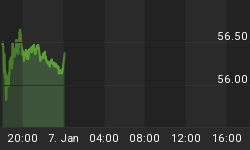The following is part of Pivotal Events that waspublished for our subscribers December 1, 2011.
SIGNS OF THE TIMES:
"Fears of a new recession that loomed over the economy this summer have all but receded."
~ AP, November 5
"I do not want the same kind of focus on safety and soundness that we have in OCC [Office of Comptroller of the Currency] and OTS [Office of Thrift Supervision]"
"I want to roll the dice a little bit more in this situation towards subsidized housing."
These highly-reckless statements were made by Congressman Barney Frank as chairman of the Financial Services Committee. He and his fellow Democrats encouraged the Fannie and Freddy disaster, that has yet to be resolved.
The good news is that Frank announced his retirement last week. The bad news is his financial legacy.
Last week's wonderfully oversold stock market was accompanied by urgent policy statements:
"Germany told to act to save Europe"
~ Financial Times, November 25
"Euro zone: Possibility of asking the IMF for more help"
~ Yahoo! Finance, November 26
Then came the big remedy:
"Fed, Five Central Banks Cut Dollar Swap Rate"
~ Bloomberg, November 30
We have often mentioned that announcements of these big "fixes" should be timed for when the market is ready to rally, rather than the other way around. It helps the true believers.
Perspective
Volatility!
Stocks, bonds, commodities, "Black Friday" shoppers, occupier-anarchists and even central bankers have been volatile. The latter have been inspired to again lower rates and add more stimulus. Old ideas, but as said in Tudor times, "One beam in a dark place hath exceeding refreshment".
The attached chart of the VIX shows the set ups to "buy" signals.
We had been looking for choppy action that would net out positive into January. The S&P low was 1075 in early October and the high was 1292 four weeks later. At 1247, the churning-around level is around 1270.
This week's jump has been outstanding and we think the accomplishment will be to keep going for some six weeks. The percent gain is not yet known.
COMMODITIES
Crude oil's action has been very good - enough to push the CRB up over the past 8 weeks.
Within this, agricultural prices (GKX) continued their decline. The high was 570 earlier in the year and the low was 406 on Friday. That's a 29% decline. The RSI got down to 30 and a decent rally is possible.
Over in the base metals, the GYX set its high at 502 in April and plunged 30% to the 350 level in early October. The third test was accomplished last week and the pattern suggests up.
In January our Momentum Peak Indicator expected speculation to surge into April, setting a cyclical high.
CREDIT MARKETS
As the saying goes, credit is money of the mind, and there is a difference of perception out there. Central bankers have been reckless in easing, but markets have been tightening.
The action in the money market continues to indicate tightening conditions.
Three-month Libor continues the rising trend that began in June at 0.245%. At 0.530% the yield had doubled. Yes, we are dealing with very small numbers, but the trend is important.
This was the case in 2008 when Libor turned up in June of that fateful year.
Perhaps increasing regard for risk is still at work.
This also shows up in the Ted-spread with its widening trend since July.
Of course, these two are integrated and the numbers are low. But, if they break out beyond current levels it would be a warning on the next return of risk.
More than likely, this would be confirmed by the gold/silver ratio rising above the trading range of the past two months.
At the long-end, markets have been tightening - rather severely as corporate spreads have moved to new "wides". With this, sovereign debt yields rose to new highs.
This is also defying central bank ambitions to lower rates where it counts, but velocity has a mind of its own in a post-bubble contraction. Spreads also have a mind of their own in defying official hopes of narrowing.
Although painful to orthodox investors and frustrating to policymakers, this is how financial history works. Interventionists still insist that lower rates will eliminate problems and restore prosperity. This phase of it essentially began in 2007 when developing concerns revived the notion that the Fed would cut administered rates and all would be well.
It still hasn't made it into the textbooks, but the most dramatic plunges in administered rates occur only during the first bear market in a post bubble contraction. Following the 1873 bubble, the Bank of England's rate plunged by 650 basis points. Following 1929, the Fed rate plunged by 500 bps as has been the case following the 2007 bubble.
History is working the way it should, which is the mind of the market. Interventionists economists and their disciples continue to suffer the consequences of a closed mind.
THE LONG BOND
The rush to 140 in August was strong enough to register an Upside Exhaustion on the Chartworks proprietary model. The action was the flight to long-dated "quality" on Euro concerns. The jump to 147 in mid-September was on the new promotion of the old "Operation Twist" from the 1960s.
Technically, following the "Exhaustion" there was the double top at 147 and 146 in late September. The test stalled out at the 145 level two weeks ago.
This reminds of the ability of the S&P to bounce off support in September - only the other way around.
The long bond can decline in price into the new year. This could be interrupted by year-end portfolio adjustments.
Link to December 2nd 'Bob and Phil Show' on Howestreet.com: http://talkdigitalnetwork.com/2011/12/markets-get-festive















